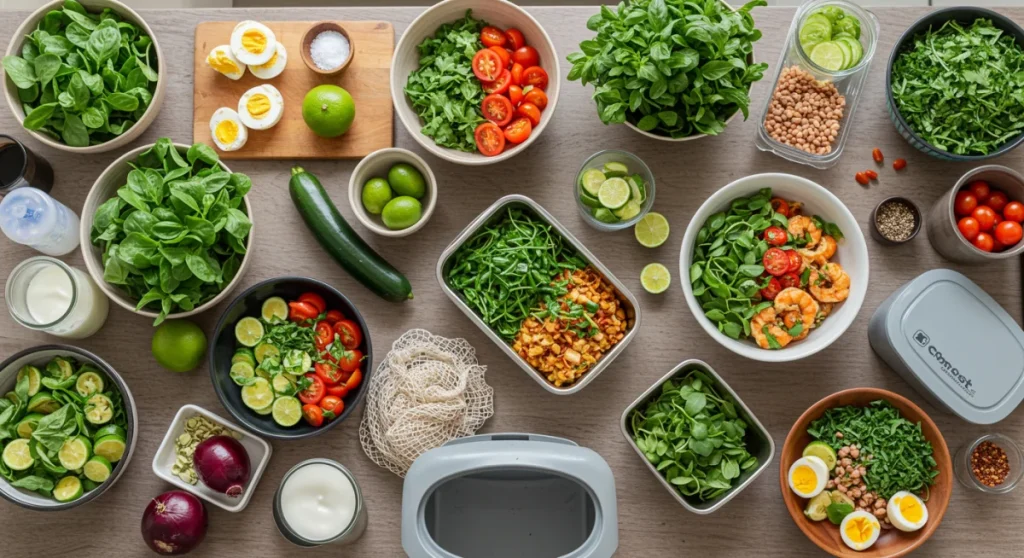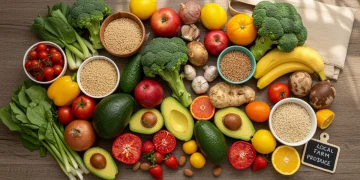Sustainable Eating 2025: Zero-Waste Recipes for a Healthier Planet

Sustainable eating in 2025 is a global movement embracing zero-waste cooking techniques to significantly reduce household food waste by up to 40% annually, fostering both environmental health and economic savings.
As we navigate 2025, the concept of sustainable eating 2025 is no longer a niche trend but a critical lifestyle choice, transforming how we approach food from farm to fork. With growing environmental consciousness and economic pressures, adopting zero-waste cooking practices has become essential for reducing our ecological footprint and optimizing our grocery budgets. This article delves into five innovative zero-waste recipes that not only utilize leftovers but are also designed to help you cut your food waste by an impressive 40% annually, contributing to a healthier planet and a more sustainable future.
The Imperative of Zero-Waste Cooking in 2025
The global food system faces immense challenges, from resource depletion to significant greenhouse gas emissions. Food waste, in particular, represents a staggering portion of these issues. In 2025, consumers are increasingly aware of their role in mitigating this problem.
Zero-waste cooking isn’t just about avoiding the trash can; it’s a holistic approach to food management that begins with mindful shopping and extends through creative meal preparation and intelligent storage. It encourages us to view every ingredient, every scrap, as a potential component of a delicious and nutritious meal, thereby minimizing what ends up in landfills.
Understanding the Impact of Food Waste
Food waste contributes significantly to climate change, as decomposing organic matter in landfills releases methane, a potent greenhouse gas. Beyond environmental concerns, the economic implications are substantial, with households losing money on discarded food.
- Environmental Burden: Methane emissions from landfills accelerate global warming.
- Resource Depletion: Wasted food means wasted water, energy, and land used in its production.
- Economic Loss: Households and businesses lose billions annually due to discarded edible food.
Embracing zero-waste cooking is a powerful step towards a more sustainable future. It empowers individuals to make a tangible difference, one meal at a time, by re-evaluating their relationship with food and its journey through the kitchen.
Recipe 1: Revitalized Veggie Scraps Broth & Risotto
This recipe exemplifies the essence of sustainable eating 2025 by transforming often-discarded vegetable scraps into a flavorful foundation for a hearty meal. Instead of tossing carrot tops, onion skins, celery ends, or herb stems, we capture their essence to create a rich, aromatic broth that elevates any dish.
The first step involves simmering these vegetable remnants to extract their full flavor profile. This broth then becomes the liquid base for a creamy, comforting risotto, ensuring that no part of your produce goes to waste. It’s a simple yet profound way to maximize nutrients and taste from ingredients you already have.
Creating Your Zero-Waste Vegetable Broth
A good broth is the soul of many dishes. Collecting and storing vegetable scraps in a designated freezer bag is a straightforward way to prepare for this. This method not only saves money but also ensures a consistent supply of homemade, preservative-free broth.
- Collect Scraps: Keep a freezer bag for onion skins, carrot peels, celery ends, mushroom stems, herb stalks, and bell pepper cores.
- Simmer to Perfection: Combine scraps with water, a bay leaf, and a few peppercorns. Simmer for at least an hour.
- Strain and Store: Strain the solids, compost them, and store the broth in jars in the fridge for up to a week or freeze for longer.
Once you have your homemade broth, the risotto becomes a canvas for creativity. You can add any leftover cooked vegetables, proteins, or cheeses you might have on hand, further reinforcing the zero-waste principle. This dish proves that resourceful cooking can lead to incredibly delicious results.
Recipe 2: Stale Bread & Leftover Veggie Panzanella Salad
Bread is a common culprit in food waste, often going stale before it can be fully consumed. This Panzanella salad offers a delightful solution, transforming day-old bread into a key component of a fresh, vibrant meal. It’s a perfect illustration of how sustainable eating 2025 encourages repurposing rather than discarding.
Beyond stale bread, this recipe is incredibly versatile, allowing you to incorporate any leftover roasted or raw vegetables that might be lingering in your fridge. Think about cherry tomatoes, cucumbers, bell peppers, or even grilled zucchini. The combination of toasted bread, fresh produce, and a zesty vinaigrette creates a satisfying texture and flavor contrast.
Assembling Your Eco-Friendly Panzanella
The magic of Panzanella lies in its ability to absorb flavors while maintaining a pleasant chewiness. Tossing the stale bread cubes with olive oil and toasting them lightly creates a delightful crunch that contrasts beautifully with the softer vegetables.
- Revive Stale Bread: Cut stale bread into cubes, toss with olive oil, and bake or pan-fry until golden and crisp.
- Gather Leftovers: Dice any leftover fresh or roasted vegetables such as tomatoes, cucumbers, onions, or bell peppers.
- Whisk a Vinaigrette: Combine olive oil, vinegar (balsamic or red wine), Dijon mustard, salt, and pepper.
- Combine and Serve: Mix the toasted bread, vegetables, and vinaigrette. Let it sit for 15-30 minutes for flavors to meld.
This Panzanella is not only delicious but also incredibly refreshing, making it an ideal meal for warmer days or a light side dish. It’s a testament to how simple adjustments in our cooking habits can lead to significant reductions in food waste without sacrificing taste or quality.
Recipe 3: “Everything But The Kitchen Sink” Frittata
The frittata is a zero-waste champion, an incredibly adaptable dish that welcomes almost any leftover ingredient. This “Everything But The Kitchen Sink” Frittata embodies the spirit of sustainable eating 2025, providing a delicious and nutritious way to clear out your refrigerator and prevent food from going to waste.
Whether you have a handful of spinach, a few slices of cooked ham, some leftover roasted potatoes, or a sprinkle of cheese, a frittata can bring them all together into a cohesive and satisfying meal. It’s quick to prepare, versatile enough for breakfast, lunch, or dinner, and always a crowd-pleaser.


The beauty of a frittata lies in its simplicity. Whisked eggs act as the binding agent, while your chosen leftovers provide flavor and texture. A quick sauté of any raw vegetables, followed by the addition of cooked ingredients and eggs, and then a finish in the oven, makes for an effortless culinary creation.
Mastering the Art of Leftover Frittata
To make a truly great frittata, consider balancing flavors and textures. A mix of vegetables, some protein, and a little cheese usually works best. Don’t be afraid to experiment with different combinations based on what you have.
- Sauté Aromatics: Start with onions or garlic if available, building a flavor base.
- Add Leftover Veggies: Incorporate cooked or raw vegetables like bell peppers, zucchini, spinach, or mushrooms. Sauté raw ones until tender.
- Introduce Proteins/Grains: Stir in cooked meats (chicken, sausage), beans, or even grains like quinoa or rice.
- Pour Eggs & Bake: Whisk eggs with a splash of milk, salt, and pepper. Pour over ingredients in an oven-safe pan. Top with cheese if desired and bake until set.
This frittata concept is a powerful tool in your zero-waste arsenal. It encourages creativity and flexibility in cooking, ensuring that even the smallest portions of leftovers find a purpose, reducing waste and maximizing the value of your groceries. It’s a perfect example of smart, delicious, and sustainable living.
Recipe 4: Repurposed Roasted Vegetable & Chickpea Wraps
Roasted vegetables are delicious on their own, but often we find ourselves with small quantities that aren’t quite enough for another full meal. This recipe transforms those lingering roasted veggies, along with any leftover cooked chickpeas or grains, into flavorful and satisfying wraps. It’s a testament to the adaptability inherent in sustainable eating 2025.
These wraps are quick to assemble, perfect for a light lunch or a quick dinner, and an excellent way to ensure that perfectly good food doesn’t get overlooked. The combination of tender roasted vegetables, protein-rich chickpeas, and a zesty dressing in a soft tortilla creates a harmonious and nutritious meal.
Crafting Your Sustainable Wraps
The key to these wraps is a good dressing that ties all the flavors together. A simple lemon-tahini or a herb vinaigrette works wonderfully, adding moisture and a burst of flavor to your repurposed ingredients. Don’t be afraid to mix and match different types of roasted vegetables, from sweet potatoes and broccoli to bell peppers and onions.
- Gather Roasted Veggies: Collect any leftover roasted vegetables (e.g., broccoli, carrots, zucchini, sweet potatoes).
- Incorporate Protein: Add cooked chickpeas, lentils, or even shredded leftover chicken for extra substance.
- Prepare a Dressing: Whisk together tahini, lemon juice, water, garlic powder, salt, and pepper, or use your favorite vinaigrette.
- Assemble Wraps: Warm tortillas, spread with a thin layer of hummus or avocado, then fill with the vegetable-chickpea mixture and a drizzle of dressing.
These wraps are not only a fantastic way to reduce food waste but also a convenient and healthy meal option. They demonstrate that with a little creativity, leftovers can be transformed into something entirely new and exciting, making sustainable eating both practical and enjoyable.
Recipe 5: Fruit Scraps & Yogurt Parfaits with Granola Crumble
Often, fruit peels, cores, or overripe pieces get discarded, but with a bit of ingenuity, they can become the star of a delightful dessert or breakfast. This parfait recipe champions sustainable eating 2025 by utilizing fruit scraps and overripe fruit, combining them with yogurt and homemade granola crumble from stale oats or cereal.
Instead of tossing those apple peels, pear cores (after removing seeds), or slightly bruised berries, we can gently cook them down into a compote. This compote, layered with yogurt and a crunchy topping, creates a satisfying and guilt-free treat that maximizes the nutritional value and flavor of every fruit piece.
Making Your Zero-Waste Fruit Parfait
The fruit compote can be sweetened minimally, allowing the natural sugars of the fruit to shine. For the granola crumble, you can use stale oats, leftover nuts, or even crushed remnants of breakfast cereal, bound together with a touch of honey or maple syrup and baked until crisp.
- Compote from Scraps: Simmer fruit peels (apple, pear), cores (seed-removed), or overripe berries with a splash of water and a pinch of cinnamon until soft. Mash lightly.
- Granola Crumble: Combine stale oats, crushed nuts, or cereal with a little melted coconut oil and maple syrup. Bake until golden and crunchy.
- Layer & Enjoy: Alternate layers of fruit compote, plain or Greek yogurt, and the homemade granola crumble in a glass.


This recipe not only prevents fruit waste but also offers a healthier alternative to store-bought desserts. It’s a wonderful way to introduce the principles of zero-waste to sweet treats, proving that deliciousness and sustainability can go hand-in-hand in your kitchen.
Embracing a Sustainable Kitchen Lifestyle
Adopting a lifestyle of sustainable eating 2025 extends beyond just recipes; it involves a fundamental shift in how we perceive and interact with our food. It’s about conscious consumption, thoughtful preparation, and innovative utilization of every ingredient. This holistic approach not only minimizes waste but also enhances our cooking skills and deepens our appreciation for the food we eat.
By integrating practices like meal planning, proper food storage, and creative repurposing, households can significantly reduce their environmental impact and save money. The five recipes outlined are just starting points, designed to inspire further experimentation and a deeper commitment to a zero-waste kitchen.
Key Pillars of a Sustainable Kitchen
Building a truly sustainable kitchen involves several interconnected practices. From making informed purchasing decisions to understanding the lifecycle of your food, each step contributes to a more efficient and environmentally friendly culinary environment.
- Mindful Shopping: Buy only what you need, and prioritize local, seasonal produce to reduce carbon footprint.
- Smart Storage: Learn proper storage techniques to extend the shelf life of fruits, vegetables, and cooked meals.
- Creative Repurposing: View leftovers and scraps as opportunities for new dishes, rather than waste.
- Composting: For unavoidable food scraps, compost them to return nutrients to the soil.
The journey towards a zero-waste kitchen is ongoing, but every small change contributes to a larger positive impact. By making these practices a regular part of your routine, you’re not just cooking; you’re actively participating in a global movement towards a more sustainable and equitable food system for generations to come.
| Key Aspect | Brief Description |
|---|---|
| Zero-Waste Broth | Utilizes vegetable scraps (peels, ends) for a flavorful and nutritious base for soups and risottos. |
| Panzanella Salad | Transforms stale bread and leftover vegetables into a fresh, vibrant, and satisfying salad. |
| Frittata Versatility | An adaptable egg-based dish perfect for incorporating any small quantities of leftover cooked ingredients. |
| Fruit Scraps Parfait | Repurposes overripe fruits and peels into a delicious, healthy compote for parfaits, reducing fruit waste. |
Frequently Asked Questions About Sustainable Eating
The main goal of sustainable eating in 2025 is to minimize environmental impact, reduce food waste, and promote healthier consumption habits. It emphasizes efficient resource use and supports ethical food production systems globally.
You can achieve a significant reduction by meal planning, proper food storage, utilizing leftovers creatively, and composting unavoidable scraps. Implementing zero-waste recipes like those discussed helps transform potential waste into delicious meals.
Not at all! Many zero-waste recipes, such as broths from scraps or frittatas with leftovers, are incredibly simple and adaptable. They encourage flexibility and creativity, making them ideal for cooks of all skill levels to adopt easily.
Adopting sustainable eating habits can lead to substantial savings. By reducing food waste, you buy less, utilize all purchased ingredients, and decrease your grocery bill. It also minimizes expenses associated with waste disposal.
Beyond recipes, supporting local farmers, choosing seasonal produce, composting, and understanding food labels are crucial. Reducing meat consumption and opting for plant-based meals also significantly contribute to a sustainable diet.
Conclusion
The journey towards sustainable eating 2025 is a collective endeavor, and every household’s commitment to reducing food waste plays a vital role. By embracing the principles and practices of zero-waste cooking, as demonstrated through these five innovative recipes, we can collectively achieve a significant reduction in food waste, contributing to a healthier planet and more resilient food systems. These recipes are not just about making meals; they are about fostering a mindset of resourcefulness, creativity, and environmental responsibility in our daily lives. Let’s transform our kitchens into hubs of sustainability, where every ingredient is valued, and waste becomes a thing of the past.





